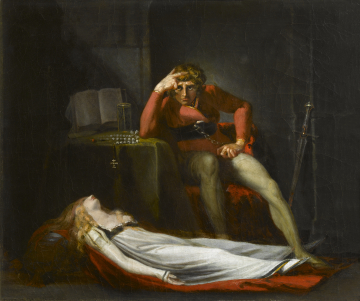Explore Collections


You are here:
CollectionsOnline
/
The Italian Count
Browse
SM P143. ©Sir John Soane's Museum, London. Photo: Art UK
Henry Fuseli RA (1741 - 1825)
The Italian Count
c.1780
Oil on canvas
Height: 49cm
Width: 61cm
Width: 61cm
Museum number: P143
On display: Picture Room
All spaces are in No. 13 Lincoln's Inn Fields unless identified as in No. 12, Soane's first house.
For tours https://www.soane.org/your-visit
Curatorial note
Fuseli painted three versions of this subject of which this is the only one currently known to survive. It is thought to be a reduced version painted as a model for the 1781 Smith mezzotint. There is a preliminary drawing for a work on this subject (Schiff 417) in the British Museum which seems to relate to one of the lost paintings (it is inscribed Zurich Feb 1779). The same composition was engraved by Lips (Schiff 781) for the French edition of Johann Caspar Lavater’s Essays on Physiognomy (1781-86) and by Holloway (Schiff 965) for the English edition of 1792. Lavater describes the composition (Vol. 2, p. 294) thus: ‘The richness of this composition takes nothing away from its simplicity. It is a knight who has just assassinated his mistress. Fettered by remorse of conscience, accused by the presence of his victim, he deplores his madness but repents it not, he detests it, and yet still applauds himself for it. A character of such force was capable of committing a premeditated crime in cold blood. Before giving himself up to it, he beheld it not in all its blackness: and even after the fatal blow, he does not yet feel it in all its enormity’.
The figure of Ezzelin is, according to Tomory, based on the bloodthirsty tyrant Eccelino da Romano (d. 1259), known as Braccioferro or Iron Arm, while Meduna featured in Fuseli’s earlier poem Der Circassier (1772) as a victim of the Corsair of Tunis. The painting appealed to Baron Gros who made a drawing from it (Louvre R.F. 29956/22) and also to Lord Byron who referred to it in his Journal (20 March 1814).
The painting was executed and exhibited in London at the Royal Academy in 1780 – the third year that Fuseli exhibited there. In the same year he exhibited two other works, Satan starting from the touch of Ithuriel’s lance and Jason appearing before Pelias. Soane returned from Italy in that year and may have seen the work at that time although he did not purchase it at that time, buying it from his friend, the painter Henry Tresham (1750-1814), in 1802.
The figure of Ezzelin is, according to Tomory, based on the bloodthirsty tyrant Eccelino da Romano (d. 1259), known as Braccioferro or Iron Arm, while Meduna featured in Fuseli’s earlier poem Der Circassier (1772) as a victim of the Corsair of Tunis. The painting appealed to Baron Gros who made a drawing from it (Louvre R.F. 29956/22) and also to Lord Byron who referred to it in his Journal (20 March 1814).
The painting was executed and exhibited in London at the Royal Academy in 1780 – the third year that Fuseli exhibited there. In the same year he exhibited two other works, Satan starting from the touch of Ithuriel’s lance and Jason appearing before Pelias. Soane returned from Italy in that year and may have seen the work at that time although he did not purchase it at that time, buying it from his friend, the painter Henry Tresham (1750-1814), in 1802.
Purchased from Henry Tresham R.A. July 1802
Literature
Britton, Union, 1827, p. 53
Soane, Description, 1830, p.15 and 41
Soane, Description, 1835, p. 20
Johann Caspar Lavater, Essays on Physiogonomy, translated William Hunter, 1789-92, Vol. II, p.294
Peter Tomory, The Life and Art of Fuseli, 1972, p.92
Mélancolie genie et folie en Occident, exhibition catalogue, Réunion des museés nationaux/Gallimard, 2005, p. 308 (cat. 166)
New Description, 2007, p. 30 and Fig. 24
The Poetical Circle: Fuseli and the British, Centro Di, Florence, 1979, 65
G. Schiff, Johann Heinrich Fussli 1741-1825, Zurich and Munich, 1973, 360
Soane, Description, 1830, p.15 and 41
Soane, Description, 1835, p. 20
Johann Caspar Lavater, Essays on Physiogonomy, translated William Hunter, 1789-92, Vol. II, p.294
Peter Tomory, The Life and Art of Fuseli, 1972, p.92
Mélancolie genie et folie en Occident, exhibition catalogue, Réunion des museés nationaux/Gallimard, 2005, p. 308 (cat. 166)
New Description, 2007, p. 30 and Fig. 24
The Poetical Circle: Fuseli and the British, Centro Di, Florence, 1979, 65
G. Schiff, Johann Heinrich Fussli 1741-1825, Zurich and Munich, 1973, 360
Exhibition history
Royal Academy of Arts, London, 1780
Johann Caspar Lavater: das Antlitz, eine Obsession, Kunsthaus Zürich, 9 February - 22 April 2001
Mélancolie: génie et folie en Occident, Grand Palais, Paris, 10 October 2005 - 16 January 2006
Johann Caspar Lavater: das Antlitz, eine Obsession, Kunsthaus Zürich, 9 February - 22 April 2001
Mélancolie: génie et folie en Occident, Grand Palais, Paris, 10 October 2005 - 16 January 2006
Soane collections online is being continually updated. If you wish to find out more or if you have any further information about this object please contact us: worksofart@soane.org.uk


